Marcia Thornton Jones's Blog, page 162
October 19, 2015
Outlining Tricks (October theme by Kristin Levine)
One of my favorite writing tricks is an outlining method I learned in a screenwriting class. The idea is to write a description of each scene on a 3x5 index card. Everything you need to know about that scene needs to fit on that one card. This means you have to think carefully about the conflicts, the characters and the solutions in each scene.
Once you have all your scenes, you arrange the cards on a bulletin board, enabling you to look at your entire story at once. Sometimes I color code cards, letting me see if I've let a subplot drop or if I have too much about one character bunched up all together.
The best part of this method is that when I sit down to write, I have a card there next to me to guide my way. It tells me what needs to happen in each scene and when the scene (or chapter) is over.
Of course, you can do this on the computer now... some programs will even create fake index cards for you! But I still love to write out each card and arrange them the old fashioned way.
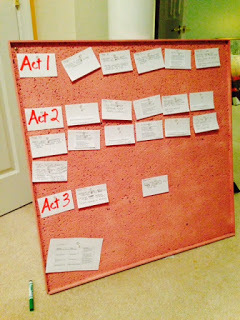 My current work in progress
My current work in progress
Published on October 19, 2015 18:49
October 18, 2015
Fake It Till You Get Used to It (October theme) by Claudia Mills
For authors, for anybody, dressing up can be a way of "faking it till you get used to it," trying on a new identity when you aren't quite ready to claim it yet.
In both my writing career and my day job career as a philosophy professor, from the start I was asked to do things I had no idea how to do. I realized right away that I needed to form the policy of saying YES to doing them, despite my ignorance, inexperience, and terror. As a professor, I needed to teach courses I had never taken, review books outside my area of expertise, give talks on subjects where my knowledge was shaky at best. As a writer, I needed to write books on new subjects and in new forms. I needed to agree to give writing workshops even though I consider myself terrible at teaching writing.
I had to dress myself up, shove myself out the (literal or metaphorical) door, and do it.
Decades ago, when I had published my very first book, I was asked to give a school presentation. I had never given a school presentation. I had no idea how to give a school presentation. I had never in my life seen any other author give a school presentation. Remember that this was in the days before the internet, before social media, before You Tube, before all these resources were available to help us know how to do scary things.
I said, "Sure."
It never occurred to me to ask how many kids I'd be speaking to, or how old they'd be, or if they'd read my book. As the book was a tween title for 10-14, I assumed they'd be kids of that age. Used to giving academic talks at that time, I wrote out a 20-page text and came prepared to read it verbatim.
I was ready!
Or not.
Mainly not.
When I got to the school, I found that my audience were kindergartners and pre-K, filing in to a cavernous gym. I stood facing these wiggling little creatures clutching my 20-page speech. And I stood there and read it, droning through every word. I didn't know what else to do. The results were about as disastrous as you could expect.
But I came away with invaluable knowledge of how NOT to do an author visit. And now my author visits are pretty darned good, and I love doing them.
So: I faked it first. And flubbed it first. And learned a lot in the process.
Tricking ourselves into facing a fear is the best treat we can give ourselves. It truly is.
In both my writing career and my day job career as a philosophy professor, from the start I was asked to do things I had no idea how to do. I realized right away that I needed to form the policy of saying YES to doing them, despite my ignorance, inexperience, and terror. As a professor, I needed to teach courses I had never taken, review books outside my area of expertise, give talks on subjects where my knowledge was shaky at best. As a writer, I needed to write books on new subjects and in new forms. I needed to agree to give writing workshops even though I consider myself terrible at teaching writing.
I had to dress myself up, shove myself out the (literal or metaphorical) door, and do it.
Decades ago, when I had published my very first book, I was asked to give a school presentation. I had never given a school presentation. I had no idea how to give a school presentation. I had never in my life seen any other author give a school presentation. Remember that this was in the days before the internet, before social media, before You Tube, before all these resources were available to help us know how to do scary things.
I said, "Sure."
It never occurred to me to ask how many kids I'd be speaking to, or how old they'd be, or if they'd read my book. As the book was a tween title for 10-14, I assumed they'd be kids of that age. Used to giving academic talks at that time, I wrote out a 20-page text and came prepared to read it verbatim.
I was ready!
Or not.
Mainly not.
When I got to the school, I found that my audience were kindergartners and pre-K, filing in to a cavernous gym. I stood facing these wiggling little creatures clutching my 20-page speech. And I stood there and read it, droning through every word. I didn't know what else to do. The results were about as disastrous as you could expect.
But I came away with invaluable knowledge of how NOT to do an author visit. And now my author visits are pretty darned good, and I love doing them.
So: I faked it first. And flubbed it first. And learned a lot in the process.
Tricking ourselves into facing a fear is the best treat we can give ourselves. It truly is.
Published on October 18, 2015 06:01
October 17, 2015
Trick or Treat (October Theme -- Sarah Dooley)
The trick is to write.
The trick is to keep writing even when it's hard.
The trick is to keep learning.
The trick is to polish.
The trick is to ask the hard questions, and answer them, and then ask the new hard questions, and then answer them.
The trick is to stick to the schedule.
The trick is to trust the story to unfold.
The trick is to rewrite, and rewrite, and rewrite again.
The trick is to share with others.
The trick is to go out on a limb.
The trick is to hit send.
The trick is to keep hitting send, even after hearing "no."
The trick is to never stop learning how to get better.
The trick is to polish, and then hit send again, and then polish, and then hit send again.
The trick is to keep writing, even while you're doing all that other stuff.
Oh, and the treat? The treat is that they send you books in the mail. And sometimes, those books are your own!

(And then sometimes your cat steals them.)
The trick is to keep writing even when it's hard.
The trick is to keep learning.
The trick is to polish.
The trick is to ask the hard questions, and answer them, and then ask the new hard questions, and then answer them.
The trick is to stick to the schedule.
The trick is to trust the story to unfold.
The trick is to rewrite, and rewrite, and rewrite again.
The trick is to share with others.
The trick is to go out on a limb.
The trick is to hit send.
The trick is to keep hitting send, even after hearing "no."
The trick is to never stop learning how to get better.
The trick is to polish, and then hit send again, and then polish, and then hit send again.
The trick is to keep writing, even while you're doing all that other stuff.
Oh, and the treat? The treat is that they send you books in the mail. And sometimes, those books are your own!

(And then sometimes your cat steals them.)
Published on October 17, 2015 19:01
October 14, 2015
My New Writing Treat by Bob Krech
We're going to be moving soon, so one of the things I'm doing to help get us there is going through the books on our shelves and thinning the collection. If you're a writer and a reader (and who cannot be both?!) you know this is not an easy task.
During this process I came across a paperback book I'd never read before, which is unusual for books in my own house. I showed it to my wife who said she had bought it years ago. It's The Great Train Robbery by Michael Crichton. It's the true story of a complex, well-crafted train robbery that took place in Victorian England. I leafed through it and after reading a few pages, I put it directly on my night table.
Now what I wanted to do was sit down and read this book immediately from cover to cover, but I have all these writing assignments and obligations (like getting the house ready to move) and I can't do that. I mean I could do that, but I shouldn't. Kind of like that bag of Cheetos or Hershey's dark chocolate. You want to open that bag and eat it all, but you know that is probably not the best thing to do. Most of the time.
So, I am treating myself with The Great Train Robbery. I am doing my writing work and moving preparations, and if I am good and put in the required hours I should, I sit down in the sun room and treat myself with a few chapter of The Great Train Robbery. Just a few.
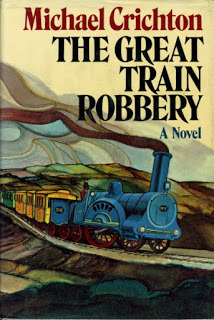 And maybe a couple of pieces of chocolate.
And maybe a couple of pieces of chocolate.
During this process I came across a paperback book I'd never read before, which is unusual for books in my own house. I showed it to my wife who said she had bought it years ago. It's The Great Train Robbery by Michael Crichton. It's the true story of a complex, well-crafted train robbery that took place in Victorian England. I leafed through it and after reading a few pages, I put it directly on my night table.
Now what I wanted to do was sit down and read this book immediately from cover to cover, but I have all these writing assignments and obligations (like getting the house ready to move) and I can't do that. I mean I could do that, but I shouldn't. Kind of like that bag of Cheetos or Hershey's dark chocolate. You want to open that bag and eat it all, but you know that is probably not the best thing to do. Most of the time.
So, I am treating myself with The Great Train Robbery. I am doing my writing work and moving preparations, and if I am good and put in the required hours I should, I sit down in the sun room and treat myself with a few chapter of The Great Train Robbery. Just a few.
 And maybe a couple of pieces of chocolate.
And maybe a couple of pieces of chocolate.
Published on October 14, 2015 23:30
Rewrite Tricks and Treats – October Theme by Tamera Wissinger
Over the past couple of months I’ve put myself on a deadline for a writing project that’s gone into the drawer and come out a few times. Right now the manuscript is going through a major story renovation and this Halloween season here are a few tricks that are helping me:
1. Showing up for short bits of time. For this project I’ve developed a habit of writing first thing in the morning. I'm using the time that I normally dedicate to journaling, and for now it's working. I may have time to come back to this story later in the day, or not. Either way, I’m slowly, consistently moving the story forward just a bit in that one hour.
2. Recognizing what isn’t working and pulling it out. I’m trying very hard to be honest with myself about this as I’m rereading and rewriting. It was painful at first, but it’s getting easier the more I do it, and having room in the manuscript leads to:
3. Capturing new ideas that I hope will strengthen the story. I didn’t go into this revision anticipating new themes or story threads, but that is what's happening as I'm cutting away the excess. What a surprise - a trick that's turning into a treat!
And here is the real Halloween treat: The Great Blue Pumpkin of Deerfield, Illinois.
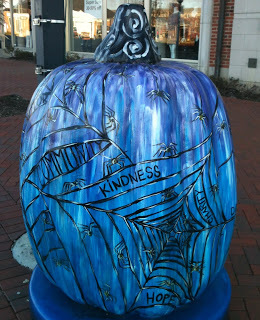 Last Halloween I was in the Chicago area and passed through Deerfield where they had a fabulous display of very large decorated pumpkins. This one was particularly interesting to me. Not only is it a blue pumpkin covered in cobwebs and spiders, but caught in the web are words: Community, Kindness, Charity, Hope. The other side reads: Wish, Care, Love. Isn’t it wonderful? I wish I knew the artist’s name so that I could give credit.
Last Halloween I was in the Chicago area and passed through Deerfield where they had a fabulous display of very large decorated pumpkins. This one was particularly interesting to me. Not only is it a blue pumpkin covered in cobwebs and spiders, but caught in the web are words: Community, Kindness, Charity, Hope. The other side reads: Wish, Care, Love. Isn’t it wonderful? I wish I knew the artist’s name so that I could give credit.
Happy Halloween, and Happy Rewriting!
~~~~~
Tamera Wissinger writes stories and poetry for children including Gone Fishing: A Novel in Verse, This Old Band, and the forthcoming There Was An Old Lady Who Gobbled a Skink, and Gone Camping: A Novel in Verse. Tamera is a big fan of Halloween, and especially appreciates the pumpkins and jack-o-lanterns. You can connect with Tamera online at her website, on Twitter, or on Facebook.
1. Showing up for short bits of time. For this project I’ve developed a habit of writing first thing in the morning. I'm using the time that I normally dedicate to journaling, and for now it's working. I may have time to come back to this story later in the day, or not. Either way, I’m slowly, consistently moving the story forward just a bit in that one hour.
2. Recognizing what isn’t working and pulling it out. I’m trying very hard to be honest with myself about this as I’m rereading and rewriting. It was painful at first, but it’s getting easier the more I do it, and having room in the manuscript leads to:
3. Capturing new ideas that I hope will strengthen the story. I didn’t go into this revision anticipating new themes or story threads, but that is what's happening as I'm cutting away the excess. What a surprise - a trick that's turning into a treat!
And here is the real Halloween treat: The Great Blue Pumpkin of Deerfield, Illinois.
 Last Halloween I was in the Chicago area and passed through Deerfield where they had a fabulous display of very large decorated pumpkins. This one was particularly interesting to me. Not only is it a blue pumpkin covered in cobwebs and spiders, but caught in the web are words: Community, Kindness, Charity, Hope. The other side reads: Wish, Care, Love. Isn’t it wonderful? I wish I knew the artist’s name so that I could give credit.
Last Halloween I was in the Chicago area and passed through Deerfield where they had a fabulous display of very large decorated pumpkins. This one was particularly interesting to me. Not only is it a blue pumpkin covered in cobwebs and spiders, but caught in the web are words: Community, Kindness, Charity, Hope. The other side reads: Wish, Care, Love. Isn’t it wonderful? I wish I knew the artist’s name so that I could give credit. Happy Halloween, and Happy Rewriting!
~~~~~
Tamera Wissinger writes stories and poetry for children including Gone Fishing: A Novel in Verse, This Old Band, and the forthcoming There Was An Old Lady Who Gobbled a Skink, and Gone Camping: A Novel in Verse. Tamera is a big fan of Halloween, and especially appreciates the pumpkins and jack-o-lanterns. You can connect with Tamera online at her website, on Twitter, or on Facebook.
Published on October 14, 2015 05:00
October 12, 2015
Writing Tricks and Treats by Darlene Beck Jacobson
Let's face it, writing isn't easy and sometimes we get so stuck in a manuscript, we can't see a way forward. Short of throwing our hands up in the air and throwing the manuscript in the trash bin, I have a few tricks I use to muddle through and make it to the other side. So when you're stuck, or hit a slump...
Try writing in a different way than usual. Instead of keyboard, try pencil and paper, or dictating into a tape recorder. Free associate and see where it takes you.
Reading outside your usual genre can provide new insight and spark creativity. I find some bits of dialogue and plot ideas from reading a wide variety of MG, YA, and adult books.
It's okay to do the easy editing first. Often working through simple fixes leads to problem solving bigger issues.
Cookies and Chocolate are writing tools not to be overlooked. Any food that feels good to the soul makes for a happier brain and attitude, often leads to inspiration. (I told you there were treats!)
Kick up your heels and get moving. Studies have shown that physical activity enhances brain function and productivity.
Singing - even badly - taps into a different part of the brain. Belting out tunes often helps with the rhythm and cadence of language. The best music is poetry afterall. And the best writing has a rhythm and poetry of its own.
Happy Tricks and Treats!
Try writing in a different way than usual. Instead of keyboard, try pencil and paper, or dictating into a tape recorder. Free associate and see where it takes you.
Reading outside your usual genre can provide new insight and spark creativity. I find some bits of dialogue and plot ideas from reading a wide variety of MG, YA, and adult books.
It's okay to do the easy editing first. Often working through simple fixes leads to problem solving bigger issues.
Cookies and Chocolate are writing tools not to be overlooked. Any food that feels good to the soul makes for a happier brain and attitude, often leads to inspiration. (I told you there were treats!)
Kick up your heels and get moving. Studies have shown that physical activity enhances brain function and productivity.
Singing - even badly - taps into a different part of the brain. Belting out tunes often helps with the rhythm and cadence of language. The best music is poetry afterall. And the best writing has a rhythm and poetry of its own.
Happy Tricks and Treats!
Published on October 12, 2015 06:30
October 11, 2015
My Collection of Treats
from Jody Feldman
I started college as a psychology major. I didn’t get very far; 1 1/4 semesters before I knew the fit was horribly off. What I did, and do, appreciate about the field is the amount of common sense surrounding it. Take positive reinforcement. I’m all over that.
For years, if I worked really hard all week to achieve my goals, I allowed myself to order in lunch on Fridays. These days, when I finish a draft or reach a long-term goal, I reward myself with a trip to the zoo or museum or plop on the couch and indulge in an afternoon of guilty-pleasure movies or TV.
I reserve my favorite treat, however, for the time when a book of mine gets released. I treat myself to a piece of artwork that, in some way, connects to the characters or themes or specific scenes in the books. It’s definitely candy for these eyes. And not fattening.
 Eyeballs by Sarah Jane Szikora reminds me of the throngs of people who showed up at University Stadium in hopes of being a contestant in the first Gollywhopper Games. It hangs to my right as I type.
Eyeballs by Sarah Jane Szikora reminds me of the throngs of people who showed up at University Stadium in hopes of being a contestant in the first Gollywhopper Games. It hangs to my right as I type.
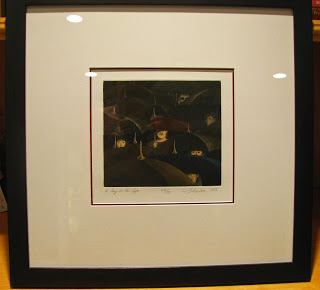 A Day in the Life by Lynn Shaler calls to mind the clandestine activities of a secret society at the center of The Seventh Level. If I push my desk chair back I can see it in the next room.
A Day in the Life by Lynn Shaler calls to mind the clandestine activities of a secret society at the center of The Seventh Level. If I push my desk chair back I can see it in the next room.
 I usually don’t buy photo art, but the main character in The Gollywhopper Games: The New Champion is always behind a camera. And so Volcano 3.5, a photograph by Maaris Cirulis, hangs in my stairway, right behind me.
I usually don’t buy photo art, but the main character in The Gollywhopper Games: The New Champion is always behind a camera. And so Volcano 3.5, a photograph by Maaris Cirulis, hangs in my stairway, right behind me.
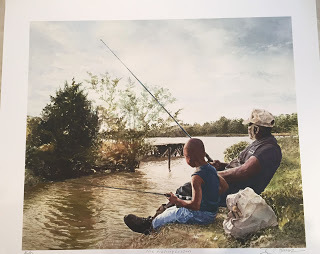 I happened upon my latest acquisition when E.B. Lewis was in town for the SCBWI Missouri Conference. Despite the fact I do not fish, I fell in love with The Fishing Lesson. The grandson is how I’d picture a younger Elijah, but I especially chose this for the fact that we have so much to learn from one another, a theme in The Gollywhopper Games: Friend or Foe. It's heading to the framer's and will soon hang near my workspace
I happened upon my latest acquisition when E.B. Lewis was in town for the SCBWI Missouri Conference. Despite the fact I do not fish, I fell in love with The Fishing Lesson. The grandson is how I’d picture a younger Elijah, but I especially chose this for the fact that we have so much to learn from one another, a theme in The Gollywhopper Games: Friend or Foe. It's heading to the framer's and will soon hang near my workspace
I started college as a psychology major. I didn’t get very far; 1 1/4 semesters before I knew the fit was horribly off. What I did, and do, appreciate about the field is the amount of common sense surrounding it. Take positive reinforcement. I’m all over that.
For years, if I worked really hard all week to achieve my goals, I allowed myself to order in lunch on Fridays. These days, when I finish a draft or reach a long-term goal, I reward myself with a trip to the zoo or museum or plop on the couch and indulge in an afternoon of guilty-pleasure movies or TV.
I reserve my favorite treat, however, for the time when a book of mine gets released. I treat myself to a piece of artwork that, in some way, connects to the characters or themes or specific scenes in the books. It’s definitely candy for these eyes. And not fattening.
 Eyeballs by Sarah Jane Szikora reminds me of the throngs of people who showed up at University Stadium in hopes of being a contestant in the first Gollywhopper Games. It hangs to my right as I type.
Eyeballs by Sarah Jane Szikora reminds me of the throngs of people who showed up at University Stadium in hopes of being a contestant in the first Gollywhopper Games. It hangs to my right as I type. A Day in the Life by Lynn Shaler calls to mind the clandestine activities of a secret society at the center of The Seventh Level. If I push my desk chair back I can see it in the next room.
A Day in the Life by Lynn Shaler calls to mind the clandestine activities of a secret society at the center of The Seventh Level. If I push my desk chair back I can see it in the next room. I usually don’t buy photo art, but the main character in The Gollywhopper Games: The New Champion is always behind a camera. And so Volcano 3.5, a photograph by Maaris Cirulis, hangs in my stairway, right behind me.
I usually don’t buy photo art, but the main character in The Gollywhopper Games: The New Champion is always behind a camera. And so Volcano 3.5, a photograph by Maaris Cirulis, hangs in my stairway, right behind me. I happened upon my latest acquisition when E.B. Lewis was in town for the SCBWI Missouri Conference. Despite the fact I do not fish, I fell in love with The Fishing Lesson. The grandson is how I’d picture a younger Elijah, but I especially chose this for the fact that we have so much to learn from one another, a theme in The Gollywhopper Games: Friend or Foe. It's heading to the framer's and will soon hang near my workspace
I happened upon my latest acquisition when E.B. Lewis was in town for the SCBWI Missouri Conference. Despite the fact I do not fish, I fell in love with The Fishing Lesson. The grandson is how I’d picture a younger Elijah, but I especially chose this for the fact that we have so much to learn from one another, a theme in The Gollywhopper Games: Friend or Foe. It's heading to the framer's and will soon hang near my workspace
Published on October 11, 2015 04:42
October 10, 2015
Haunting TauntsBy Marcia Thornton JonesTroublesome ‘what-...
 Haunting Taunts
Haunting TauntsBy Marcia Thornton Jones
Troublesome ‘what-if’ taunts often translate into crippling fear that keeps writers from writing. I thought a lot about fear when writing WOODFORD BRAVE. After all, the primary theme for my mid-grade novel is ‘courage and fear are two sides of the same coin’. So, how do we flip the coin from fear to courage when it comes to writing?
In THE JOURNEY FROM THE CENTER TO THE PAGE, Jeff Davis tell us, “We don’t have to send fear back down more deeply into its hole; we can coax it out with our flute, let it spread its terrifyingly beautiful body before us, and see what it has to teach us. Sometimes, the best advice I can offer students about fear of writing is simple: Write.” (page 176)
Sounds easy, doesn’t it? Do the very thing that scares you. In fact, that’s what my lead character does in WOODFORD BRAVE.
“I stopped then, heart pounding, blinking away the blur in my eyes. The sun glinted off something lying in the middle of Ziegler’s yard. Dad’s silver dollar mocked me from a puddle of sun. I was supposed to be a hero like my grandfather and dad, but I had no Helmet of Power or HyperSpeed Boots and this was no comic book. It was real. I was nothing but a scrawny eleven-year-old kid and I was scared spitless. I stepped into Ziegler’s yard anyway.” (Marcia Thornton Jones, WOODFORD BRAVE, page 179)
For some of us, taking that first step toward what frightens us seems impossible. We’re paralyzed by the fear. For those of us that struggle with crippling fear, here are a few strategies.
1. Write what you plan to write—jot down notes.2. Write out of sequence—write what you already know.3. Invest in a writing space and writing tools that you love.4. Schedule writing times as if you’re scheduling a doctor’s appointment (and keep them just like you keep your doctors’ appointments).5. Set quotas—word, page, or time (and reward yourself for meeting them).
And, for those of us that need a little extra push, one of these prompts might help.
1. List five personal fears. Choose one and show the protagonist facing that fear.2. What does the lead character wish he could say? Freewrite starting with: What I wanted to say was…. Finish by telling why your character can’t say those things.3. Describe the perfect family. Have the lead character compare her family to the perfect family.4. List all the things you don’t want the next scene to be about.5. Brainstorm the worst that could happen to your character. Write a paragraph where that exact worst thing happens.
How about the rest of you? How do you flip the coin from fear of failure to the courage to write when those haunting what-if goblins start to taunt?
Published on October 10, 2015 05:08
October 8, 2015
The Importance of Wearing Costumes --- by Jane Kelley
Now that it's October, everybody wants to know: "What's your costume? Who are you going to be?"
But when I was a kid, I loved wearing costumes all year long. My older cousins sent us a big box of their frilly prom dresses. When I got too old to be the Sun Princess or the Lady of the Moon, I started being in plays. That totally expanded my range. Then I could be a man, a teacher, an old woman or even, as you see in this picture, Mole from The Wind in the Willows. I'm the one on the left. My friend, Wendy Lueker, is Rat. I was very jealous because she got to have a tail!

I loved acting because I was always glad to escape myself. I thought my own life was rather dull. So I did what I could to make it more exciting. I amplified my emotions. I sought conflict. I spent a lot of time pretending to be other people.
In other words, I was getting ready to be a writer.
We put on costumes. We explore what it means to be other people. And when we do that well, we enable our readers to inhabit people too. That's how empathy begins.
Why, just today, as I sat at my desk, I got to be a witch, an evil racist, a bully, a little sister, a mom, an inventor and a boy who loves outer space.
It was so much fun -- especially being the witch.
For the record, she isn't really a witch. People think she is because she lives all by herself in a house at the edge of a woods and she spends all day making creatures.
Sound familiar?
So......who are you going to be?
But when I was a kid, I loved wearing costumes all year long. My older cousins sent us a big box of their frilly prom dresses. When I got too old to be the Sun Princess or the Lady of the Moon, I started being in plays. That totally expanded my range. Then I could be a man, a teacher, an old woman or even, as you see in this picture, Mole from The Wind in the Willows. I'm the one on the left. My friend, Wendy Lueker, is Rat. I was very jealous because she got to have a tail!

I loved acting because I was always glad to escape myself. I thought my own life was rather dull. So I did what I could to make it more exciting. I amplified my emotions. I sought conflict. I spent a lot of time pretending to be other people.
In other words, I was getting ready to be a writer.
We put on costumes. We explore what it means to be other people. And when we do that well, we enable our readers to inhabit people too. That's how empathy begins.
Why, just today, as I sat at my desk, I got to be a witch, an evil racist, a bully, a little sister, a mom, an inventor and a boy who loves outer space.
It was so much fun -- especially being the witch.
For the record, she isn't really a witch. People think she is because she lives all by herself in a house at the edge of a woods and she spends all day making creatures.
Sound familiar?
So......who are you going to be?
Published on October 08, 2015 03:30
October 5, 2015
Turning Chocolate into Kale - October Theme by Deborah Lytton
If I had a magic wand, I would wave it over chocolate and make it as nutritious as kale. Then I would eat it for every single meal.
To me, creating a novel comes in several stages. First is the idea stage. I think of that as eating candy. It's instant gratification because a new idea is so exciting, it whets the appetite for more.
Then comes the second stage, the drafting stage, which is like eating kale. This is the substance of the work where you have to put the story together. A great idea all alone isn't a novel. It needs a plot, a heroine or hero and loveable supporting characters along with a really detailed setting. There is no instant gratification here but instead the satisfaction of commitment and craft.
Finally, you have the third stage, which is the revision stage. This is my favorite treat of all because here you can polish the story until it gleams. This is like the best of all worlds, a healthy dose of leafy veggies with a dark chocolate heart on the side.
I hope when you are crafting your stories, you remember to balance the ideas with the craft and wave your imagination over it to create magic.
To me, creating a novel comes in several stages. First is the idea stage. I think of that as eating candy. It's instant gratification because a new idea is so exciting, it whets the appetite for more.
Then comes the second stage, the drafting stage, which is like eating kale. This is the substance of the work where you have to put the story together. A great idea all alone isn't a novel. It needs a plot, a heroine or hero and loveable supporting characters along with a really detailed setting. There is no instant gratification here but instead the satisfaction of commitment and craft.
Finally, you have the third stage, which is the revision stage. This is my favorite treat of all because here you can polish the story until it gleams. This is like the best of all worlds, a healthy dose of leafy veggies with a dark chocolate heart on the side.
I hope when you are crafting your stories, you remember to balance the ideas with the craft and wave your imagination over it to create magic.
Published on October 05, 2015 10:39



